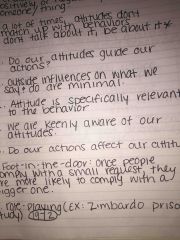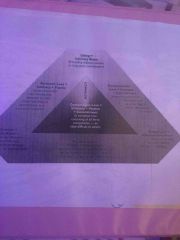![]()
![]()
![]()
Use LEFT and RIGHT arrow keys to navigate between flashcards;
Use UP and DOWN arrow keys to flip the card;
H to show hint;
A reads text to speech;
85 Cards in this Set
- Front
- Back
- 3rd side (hint)
|
Abnormal v Normal |
Depends on cultural and societal standards |
|
|
|
Psychopathology |
What has been judged as negative or dysfunctional. Includes: significant emotional pain or distress that has been labels as abnormal. Can be biological or habit driven |
|
|
|
Medical perspective |
Medications |
|
|
|
Psychological approach |
Therapy |
|
|
|
Sociocultural perspective |
Nature v nurture |
|
|
|
Culture bound syndromes |
Psychopathology relating to specific cultures |
Native Americans and "ghost sickness": preoccupation of death |
|
|
Diathesis-stress model |
Highlights you may have inherited traits/ dispositions that could be triggered by environmental factors |
Vulnerability |
|
|
Diagnosis |
Pros: finding the issue and understanding or seeking treatment Cons: negative stigmas, benefits big Pharmaceutical, imperfect system, self fulfilling prophecy |
|
|
|
DSM 5 |
Classification system for psychological symptoms and disorders |
5th edition |
|
|
Generalized anxiety disorder |
Symptoms: constant anxiety or worry. Schemas are fearful. Causes: frontal cortex is working harder to relay messages from the amygdala |
5% of Americans |
|
|
Panic Disorder |
Symptoms: Panic attacks: sharp, acute, sudden attacks of heightened anxiety. Causes: triggered by specific stimuli or a huge event. Can develop a fear of going out in public |
2% of Americans |
|
|
Claustrophobia |
Fear of tight spaces |
|
|
|
Agoraphobia |
Fear of public or open places |
|
|
|
Acrophobia |
Fear of heights |
|
|
|
Aerophobia |
Fear of flying |
|
|
|
Ophidiophobia |
Fear of snakes |
|
|
|
Somatoform disorders |
Psychological problems take on a physical form without evidence of a physical cause. |
Umbrella term |
|
|
Hypochondriasis |
Unnecessary preoccupation with physical health |
3% Americans |
|
|
Hypochondriasis |
Unnecessary preoccupation with physical health |
3% Americans |
|
|
Conversion disorder |
When a person appears to lose function of part of the body. |
Rarely seen today -Frued: hysteria |
|
|
Hypochondriasis |
Unnecessary preoccupation with physical health |
3% Americans |
|
|
Conversion disorder |
When a person appears to lose function of part of the body. |
Rarely seen today -Frued: hysteria |
|
|
Dissociative disorders |
Splitting of part of personality or memory. Serious, long term disruptions of self |
Umbrella term |
|
|
Amnesia types |
Anterograde: all memory from after the brain injury are lost. Retrograde: all memories from before the brain injury are lost. Fugue state: severe form of dissociative amnesia where a person can forget who they are |
Clive Wearing had retrograde and anterograde amnesia |
|
|
Dissociative identity disorder |
Two or more distinct personalities reside within one person (personalities may or may not be aware of each other). Could be the result of a person coping with abuse |
Multiple personality disorder |
|
|
Depression |
Symptoms are controversial but include: disparity, deep sadness lasting two weeks or more, losing interest in relationships, exaggerated feelings of hopelessness, feeling worthless, changes in sleeping and eating patterns. Gender differences: M- 5-12% F- 13-21% |
|
|
|
Bipolar disorder |
Symptoms of manic depression alternating between extreme, depressed low and extreme, manic high. Symptoms of manic state: spirited, vigorous, motivated, Grandiose Cognition |
Delusional manic highs and ultra depressed lows |
|
|
Causes of bipolar |
Too little serotonin (depressive states) Too much serotonin (manic states) Strong genetic correlation Environmental factors: stress, trauma, child abuse |
|
|
|
Schizophrenia |
Distortions of reality Symptoms: false thoughts, loose association, "word salads", hallucinations: false sensory stimuli, flat OR exaggerated/ inappropriate levels of emotion, odd behaviors and thinking they're normal. |
|
|
|
Paranoid schizophrenia |
Paranoia, suspicious, hearing voices, delusional |
Most common |
|
|
Catatonic schizophrenia |
Distorted motor abilities- either immobility or excess motor movement |
Rare |
|
|
Disorganized schizophrenia |
Illogical thinking, word salads, exaggerated displays of emotion |
|
|
|
Antisocial personality disorder |
Unusual lack of empathy or remorse (manipulative). More prevalent in males. |
|
|
|
Histrionic personality disorder |
Extreme and excessive emotionality and attention seeking. More common in women. |
|
|
|
Borderline personality disorder |
Instability of mood, relationships, and self image due to genetics and/or trauma |
Marilyn Monroe |
|
|
Psychiatrists |
MD. Specialized in treatment through medication |
|
|
|
Clinical or counseling psychologist |
PhD. Focus on diagnosis, treatment without medications (talk therapy), and research |
|
|
|
Social workers |
Masters degree. Focus on family-type problems |
|
|
|
Counselor |
Religious, family, relationship, substance abuse, child abuse (extensive personal experience) |
|
|
|
Parallel services |
Specifically designed to serve ethnic populations |
|
|
|
Fit of characteristics |
Therapist and client are similar in ethnicity, language, or background |
|
|
|
Cognitive fit |
Therapist and client are similar in world/ cultural views and perspectives |
|
|
|
Psychoanalysis |
Intensive (3-5 times/ week) extensive (can last for years) using free association and dream interpretation Goals: catharsis and insight |
|
|
|
Catharsis |
Release of trapped energy and tension |
|
|
|
Insight |
Self understanding |
|
|
|
Free association |
Saying whatever comes to mind |
|
|
|
Transference |
Duplicating feelings for another and directing them at therapist |
|
|
|
Resistance |
Missing sessions, hesitating during free association Sign that the client may be getting close to discovering the core issue |
|
|
|
Variations of psychoanalysis |
Short-term: more focused, less frequent, more direct, advice might be offered in lieu of free association |
|
|
|
Cognitive- behavioral approach |
Conditioning one to change schema and adjust the resulting behavior |
|
|
|
Classical conditioning (cognitive behavioral approach) |
US, UR, CS, CR |
|
|
|
Exposure |
Flooding: saturating the person with the phobic stimulus Graded exposure: gradual amounts of phobic stimulus |
|
|
|
Aversive conditioning |
Developing an aversion to a previously desired stimulus like Chain smoking to quit smoking |
|
|
|
Operant conditioning |
Reward and punishment |
|
|
|
Token economy |
Behaviors rewarded with tickets, tokens, etc that only hold value in that particular environment |
|
|
|
Skills training |
Role play to help move past fear or anxiety or particular situations |
|
|
|
Beck's cognitive therapy |
Problems with thinking (or cognitive errors) causing a focus on the negative aspects of situations |
|
|
|
Personalization (Beck) |
Taking personal responsibility |
|
|
|
Magnification (Beck) |
Giving all attention to tiny "bad things". Blowing things out of proportion |
|
|
|
Minimization (Beck) |
Focusing on positive aspects of a situation |
|
|
|
Rumination (Beck) |
Repetitive focus on the mood of depression |
|
|
|
Humanistic approach |
Client is the key focus. Assumptions: trust the clients growth instincts, focus on their feelings and on the present and future. Client is responsible for change |
|
|
|
Family, couple, and group therapy |
Focus on improving communication. Acknowledgment of family and group interaction. Group: 4-12 people offering social support for coping. |
|
|
|
Biological approach |
Changing how the brain works through medication, electro convulsive therapy (ECT), or psychosurgery |
|
|
|
Prozac Xanax Valium Thorazine Lithium |
Anxiety disorder Panic disorder Anxiety and panic disorders Schizophrenia Bipolar |
|
|
|
Eclectic approach |
Taking what is good and useful from any/ all techniques to help individuals |
|
|
|
Comparing approaches |
Behavior: anxiety Cognitive: depression Humanistic: self esteem Commonalities: supportive relationship providing hope and openness |
|
|
|
Social psychology |
Examines the way thoughts, feelings, and behaviors are influenced by other people |
|
|
|
Social perception |
Processes by which we perceive others |
|
|
|
Social comparison |
Influence self esteem and self image |
|
|
|
Attribution theory |
How to explain the causes of behavior with consideration for The person and the situation |
Heider |
|
|
Fundamental attribution error |
Overestimating the influence of personality and underestimating the situation |
|
|
|
Effects of attribution |
Schemas and bias |
|
|
|
Attitudes guiding actions |

Back (Definition) |
|
|
|
Cognitive dissonance |
Tension when we are aware that our actions and thoughts are not aligned |
|
|
|
Altruism |
Unselfish regard for the welfare of others. |
Empathy v apathy Evolutionary perspective |
|
|
Conformity |
Real or imagined group pressure causing one to change his attitudes and behaviors to accommodate group norms |
Ache |
|
|
Obedience |
Following orders from an authority who one feels is legit |
Milgram |
|
|
Triangular theory of love |

Back (Definition) |
Sternburg |
|
|
Systematic desensitization |
Goal: replace the fear with sense of relaxation for the same phobic stimulus |
|
|
|
General Adaptation Syndrome |
1. Alarm reaction 2. Resistance 3.exhaustion |
|
|
|
Spearmans theory of intelligence |
Two factor S- specific abilities G- general intelligence |
|
|
|
General Adaptation Syndrome |
1. Alarm reaction 2. Resistance 3.exhaustion |
|
|
|
Spearmans theory of intelligence |
Two factor S- specific abilities G- general intelligence |
|
|
|
Gardner Multiple Intelligences |
Levels of ability are different for everyone |
|

